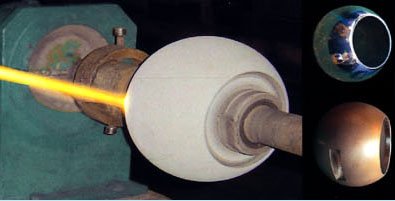In this article, we mainly look at the application and function of thermal spraying technology in the field of valves.
WHY?
In modern industrial piping systems, the main functions of the valves are to isolate, regulate flow, prevent backflow of the medium, as well as to regulate and discharge the pressure, etc. It is a vital control element, which is related to production and life safety. Some of the valves have a harsh working environment. Strong corrosion, strong scouring, and strong abrasion lead to a short service life of the valve, extremely easy to damage, and cause immeasurable losses to production. How to improve the service life of such valve components has become an important topic of common concern in various industries.
HOW?
Among all the improvement measures, thermal spraying technology is currently the most effective, cheapest and direct method to enhance the surface properties and process parameters of the key parts. This technology heats the sprayed material to a molten or semi-melted state by a heat source, and sprays and deposits it on the surface of the pretreated substrate at a certain speed to form a coating, giving the substrate surface special functions. They are mainly arc spraying, flame spraying, plasma spraying, explosive spraying, supersonic spraying, high-frequency spraying, laser spraying and spray welding, etc.
TYPE
At present, the main common coatings are Ni60, ENP, Satellite, Tungsten Carbide, Nitriding, Ni-Cr3C2, PTFE, etc.
FUNCTION
Some coatings can repair and strengthen the valve by increasing the hardness and strength of the key components, reducing abrasion during use. And some others have a lubricating effect, can prolong the service life of the valve by reducing the friction during switching.
It is the most economical and effective means to resist harsh working environments by covering a layer of suitable thermal spraying materials on the surface of different valve parts, which can be used for abrasion resistance, corrosion resistance, erosion resistance, high-temperature oxidation resistance, heat cycle and heat conduction resistance, as well as all of the above-mentioned factors, etc.
APPLICATIONS
- Erosion and abrasion resistance: Hydraulic decoking control valve
The hydraulic decoking control valve realizes the program control by controlling the flow direction of high-pressure water in the hydraulic decoking system of the delayed coking unit in the refinery.The core of this valve is a hollow structure, which is a vulnerable part of it, during use, the valve core and sleeve are prone to abrasion under the erosion of high-pressure water. The service life of the valve without coating is only about 3months.
Under such working conditions, the valve core material must with high hardness and certain toughness. If the valve core is made of such material as a whole, the production cost is very expensive. By using the surface strengthen methods can not only meet the requirements of use but also reduce the cost. Make a nickel-based self-fluxing alloy coating on the valve core surface by the flame spraying process, with a hardness up to 60HRC and excellent abrasion resistance. The coating is metallurgically combined with the substrate, and will not peel off under the erosion of high-pressure water. The service life of the valve can be increased to two years with the abrasion-resistant coating, which not only saves costs by extending the period of equipment maintenance and replacement of parts but also greatly reduces labor intensity
2. Corrosion and abrasion resistance: Check valve of high-pressure diaphragm pump
The mediums of some chemical formulation industries are highly corrosive. Long-term exposure of valves to such mediums will cause corrosion and abrasion, resulting in leakage, which increases the maintenance workload and labor intensity and causes significant losses to production.
For example, during the preparation of 1.4-butanediol (abbreviated as BDO), the BDO solution with catalyst nickel powder passes through the flow part of the diaphragm pump, causing corrosion and abrasion to the inlet check valve of the pump. Especially the valve part tightly connected to the pump, after its corrosion, solution leakage is likely to occur, causing ineffective work and the diaphragm pump to fail.
In order to increase the service life of the check valve at a low cost, a layer of cermet composite material can be prepared on the sealing part by supersonic flame spraying. The coating is uniform and dense, well combined with the substrate, the strength is as high as 70MPa, and the hardness can reach above 60HRC, with excellent abrasion and corrosion resistance. The coating will not fall off during multiple impacts of the upper and lower parts of the diaphragm pump, and its surface is smooth so that the contact parts of the upper and lower parts of the diaphragm pump can be closely matched to achieve the flow control accuracy required by the customer. The average life of the valve can be increased by more than 5 times after coating, which prolongs the maintenance cycle of the diaphragm pump, greatly saving the production cost, and providing a guarantee for long-term safe production
3. High-temperature oxidation resistance, insulation: Spool and seat of the ash discharge valve
The ash discharge valve for dust removal in thermal power plants is mainly used for the medium transportation of its ash removal system, water system, steam system and ash slurry treatment system. It requires good resistance to high temperature, pressure and oxidation, as well as insulation of the valve spool and seat. Coating the surfaces of the spool and seat with high-temperature oxidation-resistant ceramic by plasma spraying, the bonding strength of the coating and the substrate can reach 30MPa, will not cause oxidation failure during a long time work at high temperatures. The coating hardness is above 65HRC, and it is resistant to the abrasion and erosion of hard particles in the high-temperature flue gas, which meets the requirements of the valve’s working environment, reduces the manufacturing cost, and prolongs the service life of the ash discharge valve.
Ceramic-coated valves can also be used in industries such as steel, petroleum, chemical, papermaking, and biological engineering
4. Destruction caused by multiple factors: hard-sealed abrasion-resistant ball valve
The metal-sealed wear-resistant ball valve is a component used to achieve the interception and flow control of the pipeline system that requires wear resistance. It is widely used in the development of coal-based liquid fuels in coal liquefaction projects. It has a long-term operation at a high temperature of 570℃and 40MPa working pressure, with frequent switching. The medium is fly ash or cinder + N2, which is highly corrosive, with hardness 52HRC. Under such harsh working conditions, the surface of the ball valve is prone to wear, corrosion and cavitation after being put into use. Under the interaction of these factors, the service life of the valve is very short, which has a great impact on production.
Prepare the surface of the ball with a wear-resistant and corrosion-resistant coating by thermal spraying to improve the valve performance, and prolong its service life, such coating can work at high temperatures for a long time. For example, Ni-Cr3C2, the bonding force of the coating and the substrate is up to 70MPa, and its hardness is 63HRC. It will not fail at high temperatures and can work for a long time. The Ni and Cr in it are important components for corrosion resistance, while carbides provide the possibility for wear resistance. After coating, the service life of the ball valve is found to be 6 to 8 times that of the uncoated one.



